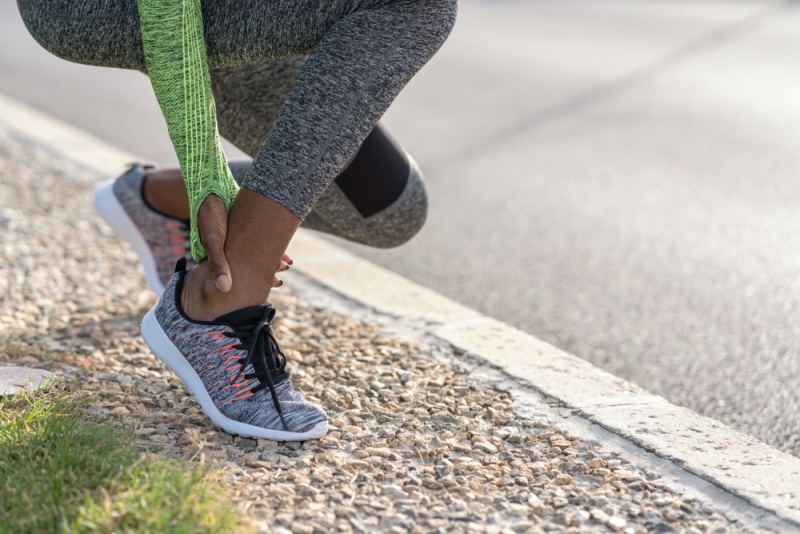Understanding Heel Pain: Causes, Treatments, and When to Seek Help
September 23, 2024Heel pain is a common issue that can significantly impact your daily life, making simple activities like walking or standing uncomfortable. It can be caused by various factors, each requiring a different approach to treatment. We spoke with Carter Andersen, DPM, a podiatrist at Saint Joseph Health System, to learn more about heel pain and how patients can treat the condition.
Common causes of heel pain
Heel pain isn't simply caused by one thing. There can be different causes for the condition, all of which might have diagnosis, prevention, and treatment options.
"Patients often ask how they can distinguish between different types of heel pain. Generally, the location of the pain provides important clues. For instance, pain located at the back of the heel often suggests achilles tendonitis, while pain that is centered on the bottom of the heel typically points to plantar fasciitis or, in some cases, heel spurs. Proper diagnosis is crucial for effective treatment," says Dr. Andersen.
Plantar fasciitis
Plantar fasciitis is the most common condition when it comes to heel pain. Approximately 2 million patients are diagnosed and treated every year. The plantar fascia is a ligament that connects the heel bone to the toes, supporting the natural arch of the foot. It's designed to handle the stresses and strains of everyday activities, like walking, running, and jumping. However, when this ligament becomes overexerted, it becomes inflamed and stiff. This is known as plantar fasciitis and can cause heel pain.
Achilles tendinitis
The achilles tendon is the largest tendon in the body, connecting the calf muscles to the heel bone. Like the plantar fascia, the achilles supports you when walking, running, jumping, and standing on your tip toes. When the tendon is overused, inflammation can occur, leading to pain, swelling, and other irritation. Tendinitis and tendon ruptures are more common in sports where athletes start and stop frequently, like tennis and football.
Heel spurs
A heel spur is a collection of calcium deposits that build over weeks, months, or even years. It's a bony outgrowth that starts at the heel bone. They develop in response to damage and strain to the surrounding soft tissues at the bottom of the heel, specifically as a result of plantar fasciitis. As the plantar fascia repeatedly places stress on the heel bone during overuse, the body responds by creating more bone in the area, resulting in heel spurs.
Bursitis
There are small sacs filled with liquid throughout the body, including shoulders, hip, knees, and heels, known as bursae. These sacs help cushion bones and soft tissues to reduce friction and stress. Bursitis occurs when the bursae in between your heel bone and achilles becomes inflamed. It mostly affects athletes who overuse their ankles without proper conditioning.
When to see a doctor
When you experience heel pain, it's important to monitor the symptoms closely. Pain in the heel might resolve with rest, over-the-counter pain relievers, or by wearing supportive shoes. However, if your heel pain persists despite these measures, it might be time to consult a health care provider.
At Saint Joseph Health System, we start with a detailed history of your symptoms. We’ll ask about how long you've had the pain, what activities make it worse or better, and any treatments you've already tried. This is followed by a physical examination, where we carefully assess the heel and surrounding structures. One common test involves checking for tightness in the calf muscles, which is often associated with conditions like plantar fasciitis, the most frequent cause of heel pain.
In some cases, we might recommend imaging tests, such as X-rays, to rule out other conditions like stress fractures or heel spurs. Based on the findings, we can accurately diagnose the problem and develop a tailored treatment plan.
"It’s important for patients to know when to seek professional care for heel pain. If you have rested, worn appropriate footwear, and tried over-the-counter pain relievers without improvement, it’s advisable to consult a healthcare provider. Persistent pain that doesn’t respond to conservative measures often requires a more thorough evaluation and tailored treatment plan," says Dr. Andersen.
Treatment options for heel pain
Treatment for heel pain varies depending on the underlying cause. Thankfully, many patients find relief with simple at-home treatments, such as:
- Rest: Reducing or modifying your activities can help alleviate the strain on your heel.
- Ice therapy: Applying ice to the affected area can reduce inflammation and numb the pain.
- Stretching exercises: Gentle stretches for the calf and foot can ease tightness and prevent further injury.
If your pain doesn’t improve with at-home care, medical intervention might be necessary. Your physician may recommend:
- Physical therapy: Guided exercises and treatments to stretch and strengthen the muscles in your foot and calf.
- Orthotics: Custom-made shoe inserts can provide support and relieve pressure on your heel.
- Steroid injections: For cases like plantar fasciitis, your physician may recommend a corticosteroid injection to reduce inflammation and provide quick relief.
Surgery is rarely needed for heel pain but may be considered in severe cases where conservative treatments have failed.
"For cases of plantar fasciitis, which accounts for a significant majority of heel pain complaints, we often recommend corticosteroid injections directly into the heel. This treatment can provide rapid relief from inflammation and pain, allowing patients to resume their daily activities more comfortably. In situations where patients prefer not to receive injections, other options such as oral corticosteroids or immobilization with a CAM boot are available," says Dr. Andersen.
How to prevent heel pain
While treatment options are available, it's important to prevent heel pain in the first place. Not only will you avoid a trip to the doctor's office, but implementing these tips in your daily life will improve your overall health as well.
- Wear proper footwear: Shoes that offer good arch support and cushioning can prevent excessive strain on your heels.
- Stretch regularly: Incorporating stretches into your daily routine can keep your calf muscles flexible and reduce the risk of tightness.
- Maintain a healthy weight: Extra weight can put more pressure on your feet, increasing the risk of heel pain.
- Listen to your body: Pay attention to early signs of pain or discomfort and take action before the pain becomes severe.
If you suffer from chronic heel pain, it’s essential to manage the condition effectively to maintain your quality of life. Regular follow-up appointments, along with continued stretching and proper footwear, can help prevent flare-ups. Additionally, support groups and online resources can offer valuable tips and moral support as you navigate your journey to better foot health.

